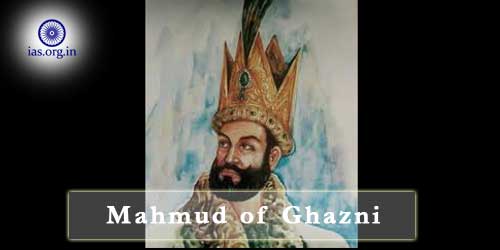A courageous soldier and a successful commander Mahmud of Ghazni ranks among those successful generals of the world who have been regarded as born commanders. He was an expert in assigning works and responsibilities to others according to their capacities, proving the fact that he was a good judge of human nature.
Under Mahmud’s command his army became a unified powerful force as his army consisted of the people of different nationalities such as Arabs, the Turks, the Afghans and even Hindus. As an ambitious commander, Mahmud always tried to win glory and expend his empire. He converted his small inheritance, from his father he inherited only the provinces of Ghazni and Khurasane into a mighty empire that stretched from Iraq and Caspian Sea in the West to the river Gange’s in the east and that was definitely more extensive than the empire of Khalifa of Baghdad at that time. Therefore, it can be asserted that Mahmud ranks among the greatest commanders and empire-builders of Asia.
Also Read: The Delhi Sultanate (1206 – 1290)
Mahmud of Ghazni: A patron of art and culture
Mahmud, an educated and cultured person, was a patron of scholarship and fine arts. Scholars of repute gathered at his court. Scholars of great repute such as Al Beruni, Utbi, Farabi, Baihaki, Tusi, Farrukhi and Firdausi were all at his court.
How much Mahmud of Ghazni loved to acquire wealth evident from an ancient involving his court poet Firdausi. Once he agreed to pay Firdausi a gold dinar for every verse composed by him. But when Firdausi brought to him his Shahnama that consisted of one thousand verse, Mahmud offered him one thousand dinars of silver that Firdausi refused to accept. Mahmud, of course, sent one thousand gold diners to Firdausi afterwards, but, by then, Firdausi had died. Mahmud established a university, a good library and a mosque at Ghazni.
He also patronized the artists; he invited all kinds of artists from all parts of his empire and even from foreign countries and engaged them in beautifying Ghazni. It is due to his unceasing efforts that Ghazni became not only a beautiful city of the East but also the Centre of Islamic scholarship, fine arts and culture.
Must Read: Administrative Structure under the Mughals
Mahmud of Ghazni as a ruler
Mahmud of Ghazni was such a just ruler that when he found his nephew guilty of having sexual relations with the wife of another person, he killed him with his own hands. Many similar stories are known about his sense of justice. He was successful in maintaining peace and order, protecting trade and agriculture and safeguarding the property and honour of his subjects within the boundaries of his empire.
Being a fanatic Sunni Musalman, Mahmud of Ghazni was intolerant not only to Hindus but even to Shias also. Al Beruni has criticized his intolerant religious acts. The contemporary Muslims considered him as the champion of Islam and he was titled as Ghazi meaning slayer of infidels and destroyer of images. The contemporary Islamic world regarded Mahmud as the destroyer of infidels and the one who established the glory of Islam at distant places like India.
Instead having all these personal characteristics, Mahmudof Ghazni was considered a great Muslim ruler. In fact, he in the history of Islam, was the first ruler who justly deserved the title of Sultan. He has been listed among the great rulers of Central Asia. He established an extensive empire, brought peace and prosperity within its boundaries, assisted in its cultural development and established the glory of Islam at distant places.
But, in the history of India, Mahmud of Ghazni was a barbaric foreign bandit, a fanatic Sunni Muslim, a plunderer and a destroyer of fine arts. He, in fact, was the ruler of Ghazni, and not of India. The parts of his empire such as Punjab, Sindh and Multan, in fact, served the purpose of bases for his invasions deeper in India. He did not pay attention to administer them well. In the course of penetrating deep in India, Mahmud of Ghazni simply desired loot, plunder and conversions. Thus to the Indians of his days he was a devil incarnate.
Also Read: Impact of Religious Policy of Aurangzeb on Mughal Empire
Weakness of Mahmud of Ghazni
His greatest weakness was that he was unable to rule as an administrator. Apart from maintaining peace and order in his dominions he did nothing to make it a stable Empire; his empire existed only during his own lifetime. As soon as he died, the empire was shattered to pieces under his successors.
According to Lane-Poole, “Mahmud of Ghazni was a great soldier and possessed tremendous courage and untiring mental and physical capacity. But he was not a constructive and far-signed statesman.” He did hardly anything to consolidate his Indian conquests as well.
It has been said by many scholar writers that Mahmud of Ghazni, who left no permanent impact on India, came like a great storm and destroyed everything and then passed off. However, it would be improper to assume, rather accept, that Mahmud of Ghazni left no permanent mark on Indians and Indian history. Mahmud of Ghazni broke up not only the military strength of the Indians but also their morale to resist Turk invaders. He never confronted a serious challenge in India and his constant success against Indians created a defeatist attitude among the Indians that Turks were invincible. And above all, the most significant achievement of Mahmud of Ghazni was the destruction of the Hindushahi Kingdom of Afghanistan that facilitated the way for the conquest of India by Turks.
Don’t Miss: Administrative Structure under the Mughals



